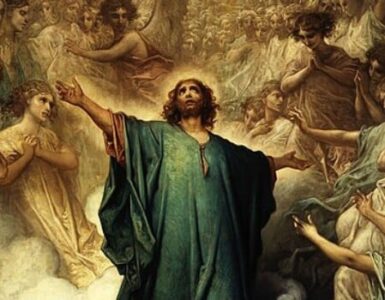This earnest question comes adapted from the lips of the young man in the Gospel: “What must I do to inherit eternal life?” (Matt 19:16). Is a person who puts the question in this form speaking a language that is still intelligible to the people of today? Are we not the generation whose horizon of existence is completely filled by the world and its temporal progress? We think primarily in earthly categories, not according to the eternal. If we go beyond the limits of our planet, we do so only to launch interplanetary flights, transmit signals to other planets, and send cosmic probes in their direction.1
Science and technology have discovered in an incomparable way man’s possibilities with regard to matter, and they dominate the interior world of his thoughts, capacities, tendencies, and passions.2 The result is that while man searches for answers in the sky, his heart has lost its ability to soar. It is tethered horizontally, in two-dimensions, to the world. So-called “modern man” has forgotten God and no longer recognizes truth, willingly accepting the most insane lies, propaganda, and ideologies ever conceived in human history.
We are reminded of Pope Saint John Paul II’s reflection on the twentieth century, which began in the hope of unlimited progress but ended as the bloodiest century known to history. Modern man had placed his hopes for a messiah in his own genius—in science, technology, and medicine. Whenever man loses sight of the “great mystery” and sets his sights only on this world, he meets disappointment, sometimes even despair.
“The world is not capable of making man happy. It is not capable of saving him from evil, in all types and forms–illness, epidemics, cataclysms, catastrophes, and the like. This world, with its riches and its wants, needs to be saved, to be redeemed.”3
–Pope Saint John Paul II
It seems that we all should have caught on to this cosmic story by now—good versus evil, light versus darkness, love versus lust—and seek the better way that has been revealed to us. Yet somehow we miss the larger story and allow our minds to be enslaved by the dictatorship of moral relativism.
“Each generation imagines itself to be more intelligent than the one that went before it, and wiser than the one that comes after it.”
–George Orwell
The result is always the same: a broken heart. As our team at the John Paul II Renewal Center was wrapping up a presentation with a group of teens, I asked them if they had anything particular that they would like us to address when we came back in a week. The topic requested…mental illness.
Why, they wanted to know, do so many of their friends and classmates suffer from anxiety, depression, gender dysphoria, and even suicidal thoughts? Suicide rates among young people have now surpassed middle-aged men, who had been the highest. They’ve heard the culture’s message, or lack thereof, loud and clear: there is no truth beyond your truth and my truth. There is no meaning of or purpose for your life beyond the one you invent for yourself. They are sensing, in their pain, that which mankind has known since the dawn of history. The human heart was made for more. It does not function well in a world void of meaning and purpose.
In the midst of the world’s brokenness, and we are all broken in one way or another, comes some very “Good News!” The path to meaning, healing, and hope, which leads to authentic love and profound happiness, can be found! First, know that there is a reason for the deep ache for something more. Solzhenitsyn is correct when he states that modern man has forgotten God, but Saint Augustine reminds us that, “our hearts are restless Lord, until they rest in You.” There is a message. There is a path. It begins with restless hearts, both yours and that of the Redeemer of Man, the Great Physician, Healer of broken, hurting, and confused hearts.
This message was amplified, and its path developed for the subsequent twenty-seven years of Pope John Paul II’s leadership. The path is “the way of man.” It involves a proper understanding of conscience, education, and human dignity. But at the heart of it all, it is the path of love. It is the path of Christ and the Saints. It is the universal call to holiness and the sanctification of everyday life.
What men and women of today and every age seek is eternal Glory, Life, and Love and only get tastes of it here on earth. In fact, all the Cosmos, created good, is meant to be a sign of (small-b) beauty that points to (big-B) Beauty: God Himself. The crowning sign of Creation, the primordial sign or sacrament, is marriage and the family—meant to not only point to God, but, when properly understood and lived, to allow man, created male or female, to enter in God’s co-creative act and participate in it. It is explained by the image and likeness of God inscribed in humanity from the beginning.
Christianity teaches us to understand temporal existence from the perspective of the Kingdom of God, from the perspective of eternal life. Without eternal life, temporal existence, however rich, however highly developed, in the end brings man nothing other than the ineluctable necessity of death. Human experience left to itself says the same as Sacred Scripture: “it is appointed for men to die once.” To which the inspired writer adds: “and after that comes judgement.” Human experience elevated by Christ, however, promises: “I am the resurrection and the life; he who believes in me, though he die, yet shall he live, and whoever lives and believes in me shall never die” (John 11:25-26).
You must make up your mind to ask the question about eternal life. For this world is passing away, and each of us is subject to its passing. Man is born with the prospect of the day of his death in the dimension of the visible world; at the same time, man, whose interior reason for existence is to go beyond himself, also bears within himself everything whereby he goes beyond the world.4
So ask Christ, like the young man in the Gospel: “What must I do to inherit eternal life?”5 Then turn your heart with all of its concerns, dreams, anxieties, and worries over to the Sacred Heart of Jesus Christ, the great Physician of human hearts.
Photo by Greg Rakozy on Unsplash
1Pope John Paul II, Dilecti Amici, No. 5.
2Ibid
3Crossing the Threshold of Hope, John Paul II, pg. 56.
4Cf. Pope John Paul II, Dilecti Amici, No. 5.
5Pope John Paul II, Dilecti Amici, No. 5.











